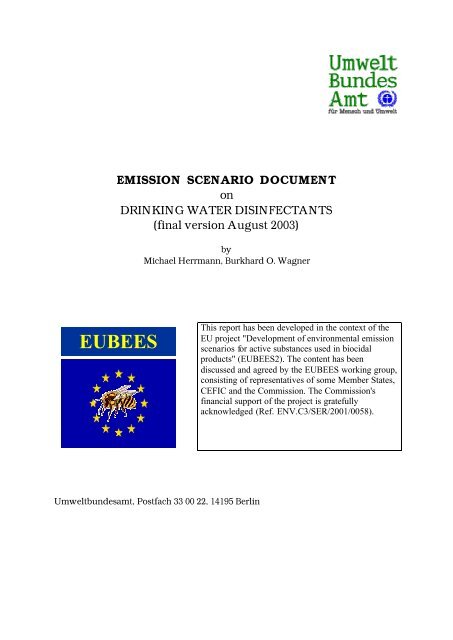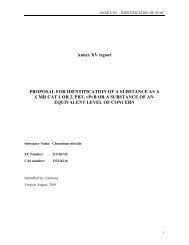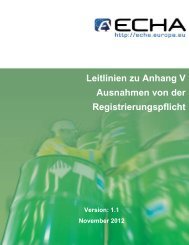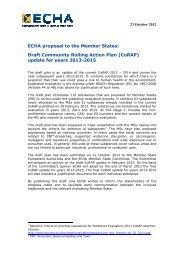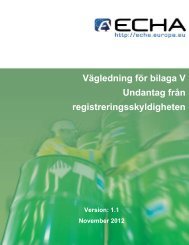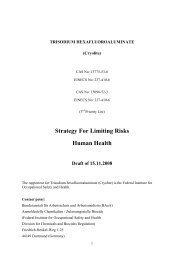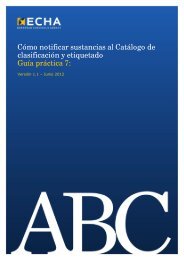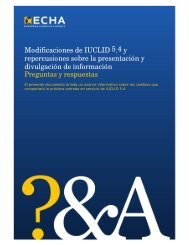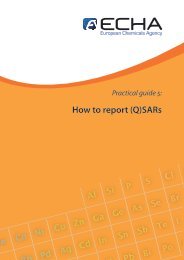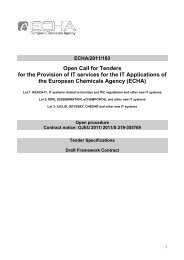EUBEES - ECHA - Europa
EUBEES - ECHA - Europa
EUBEES - ECHA - Europa
You also want an ePaper? Increase the reach of your titles
YUMPU automatically turns print PDFs into web optimized ePapers that Google loves.
EMISSION SCENARIO DOCUMENT<br />
on<br />
DRINKING WATER DISINFECTANTS<br />
(final version August 2003)<br />
by<br />
Michael Herrmann, Burkhard O. Wagner<br />
<strong>EUBEES</strong><br />
This report has been developed in the context of the<br />
EU project "Development of environmental emission<br />
scenarios for active substances used in biocidal<br />
products" (<strong>EUBEES</strong>2). The content has been<br />
discussed and agreed by the <strong>EUBEES</strong> working group,<br />
consisting of representatives of some Member States,<br />
CEFIC and the Commission. The Commission's<br />
financial support of the project is gratefully<br />
acknowledged (Ref. ENV.C3/SER/2001/0058).<br />
Umweltbundesamt, Postfach 33 00 22, 14195 Berlin
1 Preface<br />
Environmental risk assessment of drinking water disinfectants commences at the mouth of the<br />
sewer sampling system. For the vast majority of sewer the receiving “compartment” will be a<br />
municipal sewage treatment plant (STP) 1 . The microorganisms of that STP are the first biota<br />
to getting exposed to disinfectant residues in the raw water and/or reaction products of those<br />
substances. For this reason the influent concentration of the STP is to be estimated and<br />
related to adverse effects on microorganisms for purposes of risk assessment.<br />
This Emission Scenario Document was compiled for Product Type 5 of Annex V of Directive<br />
98/8/EC of the European Parliament and the Council of 16 February 1998 concerning the<br />
placing of biocidal products on the market. It rests mainly on data from Germany and the<br />
situation may be somewhat different for other EU member states. However, it is assumed<br />
that the general principles of drinking water disinfection described in this scenario apply<br />
throughout all of the EU.<br />
This interpretation draws from the fact that, unlike for other biocide product types, there is a<br />
frame legislation regime at EU level (98/83/EC) in place, setting minimum standards for<br />
certain ingredients in water for human consumption, including drinking water. Member states<br />
may prescribe additional, stricter requirements, where considered necessary – and some did<br />
so. Although aspects of human health protection drive the criteria, they also are suitable to<br />
prevent the environment from relevant risks. This holds true at least for the few currently<br />
used substances. Along with these limits, there exists (e.g. in the German Drinking Water<br />
Ordinance of 21 st May 2001) a list of substances recommended by the Competent Authority<br />
that may be used by public water suppliers.<br />
Elaborating an ESD for environmental exposure on drinking water disinfectants is very<br />
unusual and unique. It seems that all of the very reactive active ingredients will be used up<br />
during use or subsequently in the municipal canal sewer system. The data presented in this<br />
document should be regarded as illustrative and should be updated as more specific<br />
information becomes available within the review programme on existing biocidal substances.<br />
All presently employed drinking water disinfectants are highly reactive chemicals. Although<br />
lacking final analytical evidence it is assumed that, on its way to the STP almost the entire<br />
residues of the active substances will be “consumed” by the abundant organic matter<br />
contained in the wastewater. On the other side quite a bunch of generally unidentified<br />
(transient?) reaction products can be expected. Hardly any general information can be given,<br />
neither on the identities of those artefacts nor on their concentrations. Specific information on<br />
the fate of each individual drinking water disinfectant must be given in the dossier. In<br />
addition, there are established monitoring systems, which ensure that drinking water meets the<br />
requirements of the respective national drinking water regulations.It is within the<br />
responsibility of the water distribution companies to verify that the quality of the drinking<br />
water obeyes the quality standards laid down in the Council Directive 98/83/EC of 3<br />
November 1998 on the quality of water intended for human consumption (rf.[4])<br />
1 M.P. Vall, Abwasser in den europäischen Staaten – Von der Abwassersammlung und –behandlung zur<br />
Abwasserleitung. In: Statistik kurz gefasst – Umwelt und Energie, Thema 8 – 14/2001, EUROSTAT, ISSN<br />
1562-3092, http://www.eu-datashop.de/download/EN/sta_kurz/thema8/nq_01_14.pdf: „77% of the EU<br />
population are connected to a public municipal sewage treatment plant.“
C O N T E NT<br />
PREFACE 0<br />
1 INTRODUCTION 3<br />
2 GENERAL BACKGROUND INFORMATION 4<br />
2.1 LEGISLATION 4<br />
2.2 TYPES OF DRINKING WATER DISINFECTIONS 4<br />
3 ACTIVE SUBSTANCES APPLIED<br />
ERROR! BOOKMARK NOT DEFINED.<br />
3.1 CHLORINE 6<br />
3.1.1 Chemistry 6<br />
3.1.2 Definitions of Chemical Terms 7<br />
3.1.4 Pre-ammonisation 9<br />
3.2 CHLORINE DIOXIDE 9<br />
3.3 IODINE 10<br />
3.4 OZONE 11<br />
3.5 POTASSIUM PERMANGANATE 12<br />
3.6 SILVER 12<br />
3.7 ISOCYANURIC ACID COMPOUNDS 12<br />
3.8 PHYSICAL DISINFECTION M ETHODS 12<br />
3.8.1 UV radiation 12<br />
3.8.2 Micro-filtration 13<br />
4 EXPOSURE ESTIMATION FOR SEWAGE TREATMENT PLANTS (STP) 13<br />
4.1 DISINFECTION 13<br />
4.2 DISINFESTATION / DISINFECTION OF DISTRIBUTION SYSTEM 15<br />
5 DISINFECTION BY-PRODUCTS 15<br />
6 REFERENCES 17<br />
ANNEX I 19<br />
ANNEX II 22<br />
2
1 Introduction<br />
Water for human consumption is abstracted mainly from surface water (rivers, reservoirs) or<br />
from groundwater. The average abstraction in the EU15 countries is 659 m 3 .capita -1 .yr -1 for<br />
all uses [1] though there are large variations between countries and usage pattern. On average<br />
about 14 % are consumed by urban water demand, the remaining part is demanded by other<br />
sectors; among those the most dominant are agriculture (30 %), industry (10 %) and energy<br />
(25 % hydropower and cooling water for power generation).<br />
Table 1: Share of urban water abstraction in total abstraction in 1995 [1]<br />
Share of water for urban use<br />
in total abstraction<br />
Share of water for urban use<br />
in total abstraction<br />
x 10 6 . m 3 % x 10 6 . m 3 %<br />
Austria 786 33.3 Italy 7 980 14.2<br />
Belgium 744 10.6 Luxembourg 35 58.9<br />
Denmark 449 49 Netherlands 1 014 8.0<br />
Finland 421 12.6 Portugal 576 7.9<br />
France 5 946 14.6 Spain 4 667 13.2<br />
Germany 3 826 6.5 Sweden 937 34.6<br />
Greece 615 12.2 U.K. 6 337 52.3<br />
Ireland 470 38.8 EU 15 34 803 14.1<br />
There are considerable differences in drinking water consumption between EU Member<br />
States:<br />
Table 2: Water consumption by households and small business in the EU [2]<br />
year 10 6 . m 3 m 3 .capita -1 .yr -1 % of public water<br />
consumption<br />
Belgium 1998 381 41 68<br />
Denmark 1994 301 58 61<br />
Germany 1995 3 872 47 76<br />
Greece 1997 670 64<br />
Spain 1995 2 849 73 94<br />
France 1994 2 384 41<br />
Ireland<br />
Italy 1995 4 400 78 77<br />
Luxembourg 1999 23 55 64<br />
Netherlands 1996 733 47 59<br />
Austria 1997 456 56 75<br />
Portugal 1998 680 71<br />
Finland 1999 404 78 100<br />
Sweden 1995 528 60 56<br />
U.K.<br />
3
In countries with sufficient aquifers, over 75 % of the water for public water supply is<br />
abstracted from groundwater. Groundwater is generally of superior quality to surface water<br />
and requires less treatment. In the case of surface water, pre-treatment such as coagulation,<br />
sedimentation and filtration is generally used to prepare the water before its final disinfection.<br />
Hence, apt protective measures and management of raw water reservoirs are capable of<br />
minimising need for chemical disinfection of the drinking water.<br />
One peculiarity of product type 5 of the biocidal products directive is the fact that specific<br />
quality standards are set up for water intended for human consumption. This means that only<br />
substances may get approval which have demonstrated that according to use instructions do<br />
not cause harm to human health.<br />
For reasons of completeness some techniques of drinking water disinfection are included in<br />
this document which are actually not covered by the Biocidal Products Pirective: these are all<br />
physical treatments but also in-situ generation of ozone.<br />
2 General background information<br />
2.1 Legislation<br />
Ensuring the microbiological safety of the drinking water is of paramount importance. Hence<br />
it is subject to high standards ensuring the safety of drinking water through the elimination, or<br />
reduction to a minimum concentration, of constituents that are known to be hazardous to<br />
health, i.e. physical, microbiological and radiological contaminants [3]. According to EU<br />
legislation (Annex I to Directive 98/83/EC [4]) water intended for human consumption shall<br />
be free from microorganisms and parasites or other substances that may pose danger to human<br />
health. The Directive concerns the quality of water intended for drinking, cooking and food<br />
preparation whether from distribution systems, tanker, bottles or containers. Methods of<br />
treatment, encompassing disinfections, shall ensure that water conforms to the Directive. The<br />
requirements are laid down in Annex I to the Directive (parts A and B), together with<br />
parameters for monitoring (part C). Standards apply at the point where water emerges e.g.<br />
from the tap or at the point of use in food production. The Competent Authority regularly<br />
monitors the water in order to warrant that the quality standards are met. Member states may<br />
prescribe additional, stricter requirements, where considered necessary for human health<br />
protection. Indicator organisms like coliform bacteria and faecal streptococci are used as<br />
indicators to monitor routinely the water for harmful contamination prior to dumping it into<br />
the distribution system.<br />
2.2 Types of Drinking Water Disinfections<br />
Three main types of disinfection processes may be distinguished:<br />
• Primary disinfection: The main purpose is to kill the vast majority of microorganisms<br />
in order to prevent them to disturb further steps in the treatment process (clogging of<br />
filters/membranes); in many cases preceded by removal of organic matter and excess<br />
of inorganic ingredients (Fe, Mn)<br />
• Residual disinfection: Routine application in order to maintain an anti-microbial<br />
potential in the distribution system<br />
• Stand-by disinfection: High dosage-application to clean up a contaminated system or<br />
when taking a new system into use<br />
The mode of action of most of the disinfectants applied is based on their strong oxidizing<br />
property. Prior to application of the disinfectant it is highly recommended to reduce any<br />
organic and inorganic compounds (e.g. phosphorous) as much as possible as these substances<br />
may serve not only as nutrient source for microorganisms but also consume considerable<br />
4
portions of the disinfectant. Additionally, they may reduce access of the disinfectant to the<br />
target organisms, e.g. by enclosing the cells or spors.<br />
For environmental risk assessment of drinking water disinfectants<br />
• the active ingredients itself,<br />
• the reduced degradation products and<br />
• by-products potentially formed during reactions with organic compounds present in<br />
the drinking water<br />
should be subject of consideration.<br />
To this end it should be clearly stated that any reasonable effort should be taken to abstain<br />
from routine disinfection of drinking water by providing clean resource waters.<br />
3 Active Substances applied<br />
The most important chemical disinfection methods currently used comprise [5]<br />
• chlorination with salts of hypochlorous acid<br />
• chlorination with ClO 2<br />
• ozone treatment (in-situ generation of ozone is not covered by BDP)<br />
• treatment with hydrogen peroxide<br />
• silver salts (small scale)<br />
• potassium-/sodium-dichlor-isocyanurate (small scale)<br />
• potassium permanganate: KMnO 4 (small scale)<br />
• iodine (small scale).<br />
The most important physical treatments, not covered by the Biocidal Products Directive, are :<br />
• filtration<br />
• UV radiation<br />
• coagulation / flocculation.<br />
Even if it is a small number of substances used for drinking water disinfectant purposes there<br />
is wide (temporal) variation in concentrations of substance(s) applied or combinations of<br />
chemical and physical treatments among the water suppliers. Beside economic grounds, easyto-use<br />
considerations and reliability of the systems, the choice of an appropriate process<br />
depends mainly on the source water characteristics, e.g. concentration and seasonal variance<br />
of undesired ingredients, pH, etc.)<br />
Table 3: The biocidal efficiency, the stability, and the effects of pH on the efficiency of some<br />
disinfectants [6].<br />
Disinfectant Biocidal<br />
Efficiency*<br />
Stability* Effect of the pH Efficiency (pH = 6-9)<br />
Ozone 1 4 little influence<br />
Chlorine<br />
Dioxide<br />
2 2<br />
efficiency slightly increases with the increase of pH<br />
Chlorine 3 3 efficiency decreases considerably with the increase of<br />
pH<br />
Chloramines 4 1 little influence<br />
* The indicated characteristics decreases from 1 to 4 (1 is the maximum, 4 the minimum)<br />
5
NOTE: Although data are provided in this document on the most commonly used<br />
disinfectants, this does not absolve applicants from providing a full dossier encompassing all<br />
endpoints, and the data provided in that dossier will be used for emission estimation and risk<br />
assessment.<br />
3.1 Chlorine<br />
3.1.1 Chemistry<br />
Chlorine and chlorine compounds are strong oxidizing agents. Thus their reactivity can be<br />
easily dissipated in reactions with organic and inorganic materials in water before efficient<br />
disinfection can occur. Additionally they effectively oxidizes undesired flavour and odour<br />
compounds of source water. Accurate dosing of disinfectant is therefore of utmost<br />
importance to ensure efficacy throughout the water distribution system while at the same<br />
avoiding excessive over-dosing. A balance must be struck between reducing risks from<br />
microbial contamination of drinking water and the potential increase in risk from chemical<br />
contaminants that result from using any of the disinfectants.<br />
Chlorine is either directly fed to the drinking water or indirectly, i.e. as a solution in water.<br />
Addition of chlorine gas to pure water results in the formation of a mixture of hydrochloric<br />
acid (HCl) and hypochlorous acid (HOCl) according to law of mass action:<br />
+ −<br />
[ HOCl]<br />
x[<br />
H ] x[<br />
Cl ]<br />
k =<br />
[ Cl 2<br />
]<br />
Table 4: Equilibrium constant k for chlorine at equilibrium [7]<br />
Temperature<br />
[°C]<br />
0<br />
15<br />
25<br />
35<br />
45<br />
Equilibrium constant<br />
k x 10 4<br />
1,46<br />
2,81<br />
3,94<br />
5,10<br />
6,05<br />
The following reactions occur when chlorine is added to water (biocidal active species are in<br />
bold letters):<br />
Cl 2 + H 2 O ? HClO + HCl (equat. 1)<br />
HClO ? H + + OCl - (equat. 2)<br />
HCl ? H + + Cl - (equat. 3)<br />
Cl 2 + 2 OH - ? Cl - + OCl - + H 2 O (equat. 4)<br />
HClO ? H + + Cl - + O (equat. 5)<br />
The disproportionation reaction of chlorine in the near-neutral pH region (equat. 1) runs in a<br />
nearly quantitative manner and is completed within seconds (cf. Table 4). Cl 2 is only<br />
prevailing at pH < 3 (rf. Figure 1).<br />
The hypochlorous acid HClO in its non-dissociated form, predominant in the pH 5-7 region,<br />
is a more powerful oxidant than the hypochlorite anion (OCl - ) and chlorine. The degree of<br />
dissociation is therefore important for disinfection efficacy. It strongly depends on the pH (rf.<br />
Figure 1) and much less on temperature. Dissociation is poor at pH levels below 6. From pH<br />
6 to 8.5 a nearly complete dissociation of HClO occurs. Thus for disinfection with chlorine<br />
6
control of pH is critical: As a consequence, an increasing pH of the potable water requires<br />
rising amounts of chlorine for the same disinfection efficacy. Equation (5) plays a minor role,<br />
although atomic oxygen is an also a very potent oxidizing (thus also disinfecting) agent.<br />
3.1.2 Definitions of Chemical Terms<br />
3.1.2.1 “Available Chlorine”<br />
“Available chlorine” is a measurement of oxidizing capacity, expressed in terms of the<br />
equivalent amount of elemental chlorine. E.g. the concentration of hypochlorite may be<br />
expressed as available chlorine by determining the electrochemical equivalent amount of Cl 2<br />
to that compound.<br />
3.1.2.2 "Chlorine Demand"<br />
In chlorination of the water a certain part of chlorine will be consumed by water impurities<br />
(Fe ++ , Mn ++ , NO 2 - , H 2 S, organic matter) and by the piping system. The difference between<br />
the applied chlorine amount and the chlorine remaining in the water may be referred to as<br />
"chlorine demand".<br />
3.1.2.3 “Free available Chlorine“<br />
When elemental chlorine is dissolved in water, an equilibrium is established between<br />
chlorine, hypochlorous acid, and hypochlorite ion (Cl2, HOCl and OCl - , respectively). The<br />
relative amount of each present depends primarily on the pH of the system.<br />
Cl 2 + H 2 O < == > HOCl + H + + Cl -<br />
HOCl < == > OCl - + H +<br />
The chlorine as HOCl and OCl - is referred to as free available chlorine<br />
3.1.2.4“Combined Available Chlorine“<br />
Nitrogen-containing compounds such as ammonia, amines and proteins are usually present in<br />
municipal wastewater. Free available chlorine reacts readily with these materials to form<br />
chloramines in which the chlorine is described as combined available chlorine.<br />
3.1.2.5 “Total Residual (Available) Chlorine“<br />
Collective term for free and combined available chlorine. Residual chlorine is found in many<br />
chemical forms in water systems. Residuals in clean water are often predominantly free<br />
chlorine while wastewater and chloraminated water can contain mixtures of free chlorine,<br />
combined chlorine and organochlorine species. Measurement of residual chlorine can be<br />
relatively difficult where a variety of chlorine forms exist and a measurement of "Total<br />
Residual Chlorine" is often required. This total chlorine measurement is normally done by<br />
reacting the chlorine in a water sample, buffered to pH 4, with potassium iodide. All of the<br />
various chlorine compounds react with the iodide to release an equivalent amount of iodine<br />
and the released iodine is measured.<br />
7
Figure 1: Dependence of non-dissociated hypochlorous acid on pH value (ordinate)<br />
Disinfection efficacy is mainly determined by dose and time of contact, since the diffusion<br />
velocity through the membranes of bacteria or viruses controls it:<br />
with:<br />
N = N − 10<br />
− kt<br />
0<br />
N 0<br />
N<br />
t<br />
k<br />
or<br />
initial number of microorganisms<br />
final number of microorganisms<br />
time for elimination<br />
susceptibility constant.<br />
lg<br />
N<br />
N<br />
0<br />
= −kt<br />
3.1.3 Dosing<br />
Chlorine is added to water either in its gaseous form or for ease of dosage after preparing a<br />
hypochlorite/hypochlorous acid solution by adding gaseous chlorine to an aqueous solution of<br />
NaOH.<br />
The proper chlorine dosage depends upon a number of factors including:<br />
• chlorine demand<br />
• residual<br />
• contact period<br />
• temperature<br />
• pH<br />
There is no way to determine the required dosage directly without experimentation.<br />
The amount of chlorine added to water depends on the specific content of oxidizable<br />
compounds, the amount needed to kill the microorganisms, plus a sufficient reserve to<br />
maintain a minimum concentration of “free available chlorine” at each point in the water pipe<br />
8
(breakpoint). To keep up this requirement the range for chlorine dosage is about 0.1 mg.l -1 for<br />
groundwater and up to 0.5 mg.l -1 for surface water.<br />
3.1.4 Pre-ammonisation<br />
Hypochlorous acid is a very reactive compound. Therefore its concentration in the drinking<br />
water is continuously decreasing over time. In order to retain some of its disinfecting power<br />
in remote areas of extended distribution systems ammonia or ammonium salts may be added<br />
to the water to form N-chloro-compounds like monochloramine, dichloramine, trichloramine,<br />
etc. These compounds, also known as “combined available chlorine”, form a stable biocidal<br />
residual in the entire distribution system. Although, as compared to free available chlorine,<br />
combined available chlorine is much less efficient at a given level. It is useful to retain such a<br />
residual throughout the system to prevent re-infection.<br />
Depending on the pH of the water different proportions of chlorinated amines are formed<br />
thereof, spanning a range for predominance of monochloro amine (NH 2 Cl) at pH 8.5 and of<br />
trichloro amine (NCl 3 ) at pH 4. At pH 7 a mixture of monochloro amine and dichloro amine<br />
is prevailing.<br />
Conversion of free available chlorine to combined available chlorine by means of adding<br />
ammonia prevents also from formation of chlorinated phenols (offensive odour and taste).<br />
3.2 Chlorine Dioxide<br />
Chlorine dioxide (ClO 2 ) is most widely used in drinking water supplies as a very effective<br />
disinfectant as well as for oxidizing purposes (oxidation potential: 0.95 V). Unlike chlorine,<br />
chlorine dioxide remains a true gas dissolved in solution. Chlorine dioxide is clearly superior<br />
to chlorine in the destruction of spores, bacteria, viruses and other pathogen organisms on an<br />
equal residual base. Since gaseous chlorine dioxide is explosive (light, temperature) at<br />
concentrations > 300 g.m -3 (20 °C) and in aqueous solutions of > 30 g.l -1 water, it is<br />
generated in aqueous solution on site (CIP) 2 mostly from reaction of chlorite (e.g. NaClO 2 )<br />
and an oxidizing agent like mineral acids (HCl; H 2 SO 4 ) according to<br />
or like Cl 2 :<br />
5 NaClO 2 + 4 HCl à 5 NaCl + 4 ClO 2 + 2 H 2 O<br />
5 NaClO 2 + 2 H 2 SO 4 à NaCl + 4 ClO 2 + 2 H 2 O + 2 Na 2 SO 4<br />
2 NaClO 2 + Cl 2 à 2 NaCl + 2 ClO 2<br />
The oxidizing action of chlorine dioxide is based on strong electron affinity. Chlorite (ClO 2<br />
- )<br />
and chloride anions (Cl - ) are the prevailing species arising from oxidation of organic matter<br />
by chlorine dioxide.<br />
ClO 2 + 1 e - ? ClO 2<br />
–<br />
ClO 2<br />
-<br />
+ 2 H 2 O + 4 e - ? Cl - + 4 OH -<br />
(E° 25°C = 1.15 V)<br />
The lack of any significant reaction of chlorine dioxide with water is partly responsible for its<br />
retaining its biocidal effectiveness over a wide pH range [8] (cf. Figure 2).<br />
2 Clean In Place<br />
9
Figure 2: Disinfection Efficiencies of ClO 2 with Cl 2 at pH 6.5 and 8.5<br />
On the other side, under specific circumstances chlorite may be formed from chlorine dioxide:<br />
-<br />
-<br />
2 ClO 2 + H 2 O ? ClO 2 + ClO 3 + 2 H +<br />
or chlorine dioxide disproportionates in basic solution forming chlorate anion [9].<br />
2 ClO 2 + 2 HO - ? ClO 3<br />
-<br />
+ ClO 2<br />
-<br />
+ H 2 O<br />
This production of chlorate is the main disadvantage of chlorine dioxide as a water<br />
disinfection agent [10]. The amount of chlorate produced can be reduced by using<br />
hypochlorite solutions of less than 10% available chlorine in the disinfection step [11].<br />
Even though being a highly active biocide (about 80-fold that of chlorine [12]) its main<br />
application is for decolourisation and organoleptic correction of the finished water by control<br />
of odour and taste problems. It also has a better performance in virucidal and sporicidal<br />
action.<br />
Chlorine dioxide does not react as readily as chlorine with humic acids and other organic<br />
compounds; causing less problems of trihalomethanes formation during chlorine dioxide<br />
disinfection [13]. On the other hand potential adverse effects may result from the by-products<br />
chlorate and chlorite anion.<br />
Typically, chlorine dioxide is used at concentration levels between 0.1 and 2.0 mg.l -1 for<br />
water treatment [14]. In some cases the chlorine dioxide treatment is complemented by<br />
subsequent application of (small dose of) free chlorine.<br />
3.3 Iodine<br />
Iodine is an excellent prompt effective microbiocide with a broad range of action. The<br />
combination of unfavourable economies (costs about 20 times than chlorine) and possibly<br />
deleterious effects health effects on individuals with thyroid problems makes continuous use<br />
unwarranted for large public water suppliers. However, iodine disinfection has been studied<br />
intensively as an emergency drinking water disinfectant or as a disinfectant for small<br />
10
individual supplies, transient emergency situations, and preliminary military or as "pocket<br />
purifier" for travellers. [15]. Iodine is used similarly as chlorine:<br />
I 2 + H 2 O ? HIO + H + + I -<br />
Like for chlorine the equilibrium strongly depends on the pH. At pH 5 about 99 % is present<br />
as molecular iodine while 88 % are present as hypoiodous acid at pH 8. Effective<br />
concentrations for iodine/hypoiodous acid are in a range of 0.25 – 2.5 mg.l -1 [16]<br />
3.4 Ozone<br />
Note: In-situ generation of ozone (O 3 ) is not covered by the BPD. Nevertheless for reasons of<br />
completeness it is included here.<br />
Ozone is a very powerful oxidizing agent (at a potential of + 2.07 V stronger than chlorine,<br />
chlorine dioxide or hypochlorous acid). For safe disinfections a concentration of 0.3 – 0.4<br />
mg.l -1 at a contact time of 4 minutes is recommended.<br />
Ozone is generated on site by electronic corona discharge in pure oxygen or in air.<br />
Accomplished concentrations in this endothermic process are around 50 g.m -3 from air and<br />
100 g.m -3 from oxygen. The gas is dissolved in water in proportion to its partial pressure in<br />
the overlaying gas phase:<br />
Table 5: Solubility of ozone in water (at 10 g.m -3 in the head space) [17]<br />
Temperature<br />
[°C]<br />
Water solubility<br />
[mg.l -1 ]<br />
5 4.4<br />
10 3.8<br />
20 2.9<br />
In acidic solution the ozone molecule is the active ingredient; at increasing pH OH . radicals<br />
are formed from ozone that cause the oxidizing effects. For oxidation of organic traces in the<br />
water 0.5 – 3.0 mg.l -1 ozone are normally required, corresponding to 0.5 – 1,5 g ozone. g -1<br />
DOC. Due to its toxicity the residues of ozone must not exceed 0.05 mg.l -1 . In order to<br />
comply with this limit residues have to be reduced either by adding reducing agents (sulfites<br />
or sodium thiosulfate) or combined with subsequent sand filtration passage and/or an<br />
adsorption step (activated carbon).<br />
Surpluses of ozone may be transformed to hydrogen peroxide according to:<br />
O 3 + H 2 O à H 2 O 2 + O 2<br />
H 2 O 2 is also a very potent oxidizing agent and thus of strong germicidal power. The high<br />
reactivity prevents a lasting concentration in extended water pipe systems from the feeding<br />
point until the final tap; a collateral chlorination is often required.<br />
Ozone decomposes relatively fast in water, making it a less suitable agent for extended<br />
distribution systems. For this reason ozone is often used for instant disinfection, demanding<br />
(substantially reduced) addition of chlorine, to retain a necessary residual.<br />
11
3.5 Potassium Permanganate<br />
KMnO 4 is normally employed as an oxidizing agent, but not for disinfectant purposes in the<br />
final step of drinking water treatment. For concrete-lined distribution pipes, which are to be<br />
put on stream for the first time 50 mg.m -3 for 12–24 hours, are recommended to clean up the<br />
system.<br />
Beside its bactericidal efficacy, KMnO 4 is also effective against filamentous algae. 0.5–2.0<br />
g.m -3 are therefore used to control those species in infiltration and reaction basins. Its impact<br />
is thereby based on a combination of toxicity, light attenuation, combined flocculation of<br />
algae and Mn(IV)oxyhydrate [18].<br />
3.6 Silver<br />
Metal ions adsorb to membranes of bacteria, causing lethal effects. Silver salts are commonly<br />
employed for this purpose. This oligodynamic effect requires higher contact time (several<br />
hours) and causes significantly higher costs than other disinfection methods. As a result they<br />
are normally restricted to special smaller case applications or mobile set-ups, like<br />
conservation of water tanks on ships (also for preservation), spare time activities, emergency<br />
measures, etc. In some cases Ag + is applied as catalytic component in special “systems”<br />
containing H 2 O 2 . Concentrations of silver in the water should not exceed 80 µg.l -1 .<br />
3.7 Isocyanuric Acid Compounds<br />
These products (sodium dichloroisocyanurate dihydrate / anhydrous, trichloroisocyanurate)<br />
are employed only in rare cases: Either in case of emergency (flood, earthquake etc.) or for<br />
disinfection and cleaning of waterworks apparatus and distribution systems.<br />
The final concentrations in the water used to wash installations do not exceed 1000 mg.l -1 of<br />
free chlorine. After cleaning and disinfection, the installation is flushed to ensure that the<br />
residual concentration is acceptable to consumers. Permission or consent for disposal of<br />
wastewater generated to the sewer must be obtained from the local water authorities.<br />
For emergency use and grossly contaminated water sources sodium dichloroisocyanurate and<br />
potassium dichloroisocyanurate are recommended at 20 – 40 mg.l -1 as a minimum for safe<br />
antimicrobial effect, if the water sources are grossly contaminated. They are formulated as<br />
easy-to-use tablets for dosing e.g. 1 litre. It is recommended that consumers should be<br />
exposed to this treated water for only as long as is required to restore conventional treatment.<br />
3.8 Physical Disinfection Methods<br />
Although not involving biocides these methods are mentioned also. UV irradiation and<br />
membrane processes are increasingly used to replace, or at least greatly reduce, the use of<br />
chemical disinfection.<br />
For some biocides incubation periods of about 48 hours are necessary to prove microbial<br />
infection of drinking water systems, while physical treatments are of immediate action.<br />
Unlike chlorination the continuously operating physical disinfection techniques also prevent<br />
from unperceived microbial contamination. Furthermore, no undesired by-products are<br />
formed from disinfectants (e.g. trihalomethanes). Before operating without residual<br />
disinfectant, considerable renovation and cleaning may be required to prevent from serious<br />
post-treatment contamination. In some cases a low dose of chemical disinfectant is still added<br />
to provide a residual in distribution.<br />
3.8.1 UV radiation<br />
The short-wave radiation spectrum of mercury lamps (e.g. ? = 254 nm) is employed to cause<br />
lethal damage to the DNA of microbes. The raw water should (normally) be pre-treated<br />
(coagulation/flocculation) in order to minimise light attenuation from suspended matter or<br />
12
iron content. The necessary dose is a function of radiation intensity (about 40 mJ.cm -2 ) and<br />
duration of impact (few seconds).<br />
3.8.2 Micro-filtration<br />
A range of pressure-driven membrane processes – micro-filtration, ultra-filtration, nanofiltration,<br />
reverse osmosis - in order of decreasing pore size- are also capable of disinfection<br />
as well as retention of chemical contamination, depending on pore size. In particular at multistage<br />
facilities and combined with UV radiation or ozonisation they are capable of producing<br />
drinking water quality from polluted reservoirs and/or salty source water.<br />
4 Exposure Estimation For Sewage Treatment Plants (STP)<br />
4.1 Disinfection<br />
Decay of residual disinfectants starts after leaving the tap during domestic application, in the<br />
sewer, in the sewage treatment plant and in the river receiving the discharge of the STP. Yet<br />
the microorganisms of the STP are the primary non-target organisms to be protected. In a<br />
first simplified approach on estimating the exposure of STP microorganisms it can be<br />
assumed that:<br />
• the recommended maximum concentration of disinfectant residual is assumed to leave<br />
the tap,<br />
• the STP is exclusively fed by water originating from the water supply (no dilution<br />
from precipitation),<br />
• during use (washing, cooking, toilet flushing, etc.) and in the municipal canal sewer<br />
system it can be expected that the disinfectant be in contact with an excessive surplus<br />
of dissolved and suspended organic matter 3 ,<br />
• decomposition during residence time in the municipal canal sewer system is taken into<br />
account,<br />
• the residence time (time for biotic/abiotic degradation) in the municipal canal sewer<br />
system from the tap (in the household) to the STP is assumed to be one hour. This<br />
assumption is based upon the average distance of 4.5 km from the household to the<br />
STP and an estimated flow rate of 1.5 km in 20 minutes in the municipal canal sewer<br />
system. The temperature of the wastewater being 12 °C on average.<br />
The following “reaction” (disappearance of the disinfectant) is assumed:<br />
D + R = DRP<br />
where is:<br />
D = disinfectant<br />
R = any reactants in municipal canal sewer system<br />
DRP = disinfectant reaction product entering the STP.<br />
The kinetic equation for the influent concentration into the STP is:<br />
3 The chemical oxygen demand of drinking water, expressed in mg.l -1 O 2 [measured by<br />
consumption rate of potassium permanganate] should not exceed 5 mg.l -1 .<br />
13
dC<br />
dt<br />
influent<br />
= −kC<br />
drinkingwater<br />
C influent = C drinkingwater * e -kt<br />
with:<br />
Variable Symbol unit default S/D/O/P<br />
INPUT<br />
Maximum concentration of C drinking water mg.l -1 P P<br />
disinfectant in drinking<br />
water at the tap<br />
Reaction rate constant in<br />
k d -1 S *<br />
sewer system<br />
Residence time in<br />
T hr 1 D<br />
municipal sewer system<br />
OUTPUT<br />
Influent concentration of<br />
disinfectant in STP<br />
C influent mg.l -1 O<br />
S = data set from applicant, D = default, O = output, P = pick list (e.g. Table 6).<br />
* Note: Due to the heterogenous and varying composition of raw waters such rate<br />
constant can normally be just estimated, e.g. by measuring rates with “reference”<br />
components, or drawing from efficacy data.<br />
In a more in-depth approach kinetic models may be applied to estimate decay of the<br />
disinfectant and its reaction products. Yet this requires consideration of various related<br />
reaction steps and includes apt data for rate constants. As an example it is referred to the risk<br />
assessment for sodium hypochlorite within the EU risk assessment for existing chemicals<br />
(Annex II to this document). The authors of that model estimated a quick elimination of<br />
NaOCl/CLO - ("free available chlorine" or FAC) during transport in the sewer. From the<br />
abundancy of reduced reaction partners in the waste water and high rate constants they<br />
estimated that FAC would drop to 10 -32 µg.l -1 at the end of the sewer. Among other reacting<br />
products chloramines are formed which itself is very reactive and acts as an oxidiser of<br />
reduced (in)organics thus being used up in the sewer and in the activated sludge.<br />
For assessing risk to STP microorganisms the standardised STP parameters from the<br />
Technical Guidance Document 2003 [19] shall apply, respectively. As already mentioned,<br />
there is a wide span for type and concentration as well as combination of chemical<br />
disinfectants applied by public water suppliers over Europe, including temporal variations<br />
within the same work. In Table 4.1 a range is given for most common concentrations that can<br />
be expected as reasonable worst-case concentrations (= C drinkingwater ) for exposure assessment.<br />
Table 6: Default values for disinfectant residuals in tap water<br />
"free available chlorine" 0.3 – (0.6) mg.l -1<br />
chlorine dioxide 0.1 – 2.0 mg.l -1<br />
Ozone 0.05 mg.l -1<br />
For the existing drinking water disinfectant actives it is expected that the reaction rate<br />
constant k is as high as to avert any relevant residual of the active ingredient in the wastewater<br />
14
on entering the STP tanks. At normal operating conditions potential minor remainings are<br />
then – at the latest - either “consumed up” by the organic matter in the primary settler or<br />
released to the atmosphere. So, there is a sort of staggered system of barriers, which<br />
minimises disinfectant residues from entering the aquatic environment. This expectation gets<br />
true evidence from day-to-day practice in running municipal STPs all over the EU.<br />
Note: The Technical Guidance Document for Risk Assessment foresees that on a local scale<br />
all waste water is collected in a sewer system and subsequently undergoes treatment. In some<br />
cases it may be appropriate to assume that no connection to a public sewerage system be in<br />
place, thus public waste water is directly discharged to surface water. The residual<br />
concentrations (efficacy data provided by applicator) should be used as starting concentration<br />
for further risk consideration.<br />
4.2 Disinfestation / Disinfection of Distribution System<br />
As a worst-case it can be assumed that microbial contamination has been observed, or a pipe<br />
burst has occurred which requires immediate remedial measure to restore quality standards.<br />
A tenfold concentration of disinfectant concentration is assumed to be applied for this purpose<br />
("super chlorination"). Unlike for routine dosage, this application is an irregular one and can<br />
be classified as intermittent release type (duration less than 24 hours, less than once per<br />
month).<br />
Such (smaller scale) operations are undertaken only in selected sectors of the distribution<br />
system since the concentration of the disinfectant in the water exceeds the limits set in<br />
national drinking water legislation. Hence, the water is collected separately after required<br />
contact time and either pre-treated or diluted prior to release to the drain. In addition shock<br />
treatments require to clean equipment are followed by extended rinsing steps. Permission or<br />
consent for disposal of any wastewater generated to a sewer or watercourse must be obtained<br />
from the relevant water Service Company or environmental authority, as appropriate.<br />
5 Disinfection By-Products<br />
Dosing highly reactive species like hypochlorous acid, ozone or chlorine to water does not<br />
mean selective reaction with target organisms but also causes reaction with other other<br />
organic and inorganic constituents of the water (mainly fulvic and humic acids) ([20], [21],<br />
[22]) forming low-molecular weight compounds from cracking of larger organic molecules<br />
[23] and/or chlorination reactions. This may render previously “harmless” substances to<br />
potentially "harmful". There are numerous by-products of water disinfections [23] that are<br />
still not fully understood and can be potentially harmful [24]. Some of these substances, e.g.<br />
trihalomethanes, generated during chlorination or bromate (BrO 3<br />
-<br />
), formed from bromide<br />
during ozone treatment are proven or suspected to be potent carcinogens. Though present in<br />
the water generally in very low concentrations, daily ingestion by humans or continuous<br />
exposure of the environment may cause a risk on the long run.<br />
Concentration of such by-products formed during disinfection treatment can be controlled by<br />
minimizing DOC 4 content. Hence, not only for saving disinfectant costs any reasonable<br />
attempt should be undertaken to remove precursor compounds prior to adding the disinfectant.<br />
Disinfections should not compensate for poor water treatment quality.<br />
According to Directive 98/83/EC on quality of water for human consumption the following<br />
concentration limits for volatile chlorinated hydrocarbons should not be exceeded:<br />
4 Dissolved Organic Carbon<br />
15
Table 7: Standards for maximum concentration limits of trihalomethanes,<br />
set out in Directive 98/83/EC<br />
S TRIHALOMETHANES<br />
- trichloromethane (chloroform)<br />
- dichlorobromomethane<br />
- chlorodibromomethane<br />
- tribromomethane (bromoform)<br />
-1 5)<br />
100 µg.l<br />
tetrachloroethene + trichloroethene 10 µg.l -1<br />
1,2 dichloroethane 3 µg.l -1<br />
The kinetics of reaction products formed in the reaction of the disinfectant with water<br />
constituents should be provided in the dossier qualitatively, preferably quantitatively and,<br />
according to the BPD, the applicant should assess the risks of by-products formed. In<br />
principle two types of reaction pattern can be distinguished:<br />
• the reaction by-product (S) is environmentally stable and does not degrade further, or<br />
• the reaction by-product (S) is environmentally instable and does degrade further<br />
(Figure 3).<br />
120<br />
Concentration<br />
100<br />
80<br />
60<br />
40<br />
20<br />
Presence of S<br />
without degradation<br />
Presence of original<br />
substance<br />
Presence of S with<br />
degradation<br />
0<br />
0 50 100 150 200<br />
Time<br />
Figure 3: Decay of original substance (disinfectant) and occurrence of degradable or<br />
non-degradable by-product (S)<br />
5 "must not" from 24 November 2008 (during 24 November 2003 : 150 µg.l -1 )<br />
16
6 References<br />
1 European Environmental Agency (1999)<br />
Sustainable water use in Europe - part 1: Sectoral use of water.<br />
http://reports.eea.eu.int/binaryeenviasses01pdf/en/tab_abstract_RLR<br />
2 Vall, M.P.<br />
Water resources, abstraction and use in European countries<br />
EUROSTAT – Statistics in Focus, issue date 02/05/2001<br />
ISSN 1562-3092.<br />
3 Guidelines for Drinking – Water Quality<br />
Volume 1 Recommendations<br />
WHO 1993, ISBN 92 4 154460 0; Addendum to Volume 1<br />
WHO 1998, ISBN 92 4 154514 3. 2nd edition.<br />
http://www.who.int/water_sanitation_health/index.html<br />
4 4 Directive 98/83 of the Council (3. November 1998) on quality of water for<br />
human use. OJ L 330 of 5 December 1998, 32-54 + L 45/55 -<br />
http://europa.eu.int/comm/environment/water/water-drink/index_en.htm<br />
5 German Federal Environmental Agency (1998)<br />
BIOEXPO-Release estimation for 23 biocidal product types<br />
UBA-Report 106 01 065, Umweltbundesamt Berlin.<br />
6 Hoff, J.C.; Geldreich, E.E.,<br />
Comparison of the biocidal efficiency of alternative disinfectants,<br />
in Proceedings AWWA seminar, Atlanta, Georgia, June 15, 1980.<br />
7 Thielemann, H. (2001)<br />
Grundlagen der hygienischen Trinkwasserdesinfektion<br />
Gesundheitsingenieur - Haustechnik - Bauphysik – Umwelttechnik, Vol.122, No. 1,2,<br />
pp. 38-45, 85 – 90.<br />
8 Benarde, M.A., Israel, B.M., Olivieri, V.P., Granstrom M.L. (1965)<br />
Efficiency of chlorine dioxide as a bactericide<br />
Appl. Microbiol., Vol.13 pp. 776-780.<br />
9 Gordon, G., R. G. Keiffer and D. H. Rosenblatt. 1972.<br />
The Chemistry of Chlorine dioxide.<br />
In: Progress in Inorganic Chemistry. S. J. Lippard, Editor. Vol. 15: 201-286. Wiley,<br />
NY.<br />
10 Couri, D. M. S. Abdel-Rahman and R. J. Bull. 1982.<br />
Toxicological Effects of Chlorine dioxide, Chlorite and Chlorate.<br />
Envir. Health Perspect. 46: 13.<br />
11 Gordon, G., L. C. Adam, B. P. Bubnis, B. Hoyt, S. J. Gillette and A. Wilczak. (1993)<br />
Controlling the Formation of Chlorate Ion in Liquid Hypochlorite Feedstocks.<br />
Journ. Amer. Water Works Assoc. 85(9): 89-97.<br />
12 Fair, G.M., J.C. Geyer (1958)<br />
Elements of water supply and waste water disposal<br />
5 th edition, John Wiley Sons Inc.<br />
13 Symons, Jr. M. (1976)<br />
Interim teatment guide for the control of chloroform and other trihalomethanes.<br />
Cincinnati, Water Supply Division, U.S EPA.<br />
14 Gordon G, S., Tachiyashiko (1991)<br />
Kinetics and Mechanisms of the formation of chlorate ion from the hypochlorous<br />
17
acid/chlorite ion reaction at pH 6-10<br />
Environ. Sci. Technol. Vol.25, No.3, pp.468-474.<br />
15 Block, S. S. (1991)<br />
Disinfection, Sterilisation and Preservation<br />
Lea & Feibinger, Malvern PA, 4 th ed.<br />
ISBN 0-8121-0863-9.<br />
16 Gottardi, W. (1991)<br />
Iodine and iodine compounds<br />
in: S.S. Block (ed.) Disinfection, sterilization and preservation<br />
Lea & Febinger, Malvern PA, 4 th ed., ISBN 0-8121-0863-9, pp. 152-166.<br />
17 DVGW -Deutsche Vereinigung des Gas- und Wasserfachs (1987)<br />
Merkblatt W 225 Ozon in der Wasseraufbereitung.<br />
18 DVGW – Deutsche Vereinigung des Gas- und Wasserfachs (1980)<br />
Merkblatt W132 Algenmassenentwicklung in Langsamsandfiltern und Anlagen zur<br />
künstlichen Grundwasseranreicherung – Möglichkeiten zu ihrer Vermeidung.<br />
19 European Communities (2003)<br />
Technical Guidance Document on Risk Assessment in support of Commission<br />
Directive 93/67/EEC on Risk Assessment for new notified substances, Commission<br />
Regulation (EC) No 1488/94 on Risk Assessment for existing substances, Directive<br />
98/8/EC of the European Parliament and of the Council concerning the placing of<br />
biocidal products on the market<br />
20 Minear, R.A., Amy, G. (1995)<br />
Disinfection By-Products in water treatment – The chemistry of their formation and<br />
control, CRC; ISBN 1566701368.<br />
21 Reckhow, D.A., Singer, P.C. (1990)<br />
Chlorination by-products in drinking water: from formation potentials to finished<br />
water concentrations, J. Am. Water Works Assoc. 82[4], pp.173-180.<br />
22 Nissinen T.K., Miettinen I.T., Martikainen P.J., Vartiainen T (2002).<br />
Disinfection by-products in Finnish drinking waters,<br />
Chemosphere 48, pp. 9-20.<br />
23 Hoof, F., van (1986)<br />
Formation and removal of organic micropollutants in drinking water treatment<br />
in: A. Bjorseth, A. Angeletti (eds.) Organic micropollutants in the aquatic environment<br />
D.Reidel Publishing Comp., Dordrecht pp. 364-372.<br />
24 WHO (1996)<br />
Guidelines for Drinking –Water Quality (1996)<br />
Vol. 2 Health criteria and other supporting information<br />
ISBN 92 4 154480 5<br />
18
Annex I<br />
Human-health based limits for drinking water quality (WHO 1996 [22]); some of the values<br />
are of provisional value, no figure given means that no adequate data to permit<br />
recommendation are available.<br />
Disinfectants Guideline value (mg.l -1 )<br />
monochloro amine 3<br />
di- and trichloro amines<br />
Chlorine<br />
chlorine dioxide<br />
For effective disinfection there should be a residual<br />
concentration of free chlorine of = 0.5 mg.l -1 after at least<br />
30 minutes contact time at pH
Disinfectants Guideline value (mg.l -1 )<br />
dibromochloromethane 100<br />
bromodichloromethane 60<br />
chloroform 200<br />
Chlorinated acetic acids<br />
monochloroacetic acid<br />
dichloroacetic acid 50<br />
trichloroacetic acid 100<br />
chloral hydrate<br />
(trichloroacetaldehyde)<br />
10<br />
chloroacetone<br />
Halogenated acetonitriles<br />
dichloroacetonitrile 90<br />
dibromoacetonitrile 100<br />
bromochloroacetonitrile<br />
trichloroacetonitrile 1<br />
cyanogen chloride (as<br />
CN)<br />
70<br />
chloropicrin<br />
WHO recommendation for microbiological quality of drinking water (1996):<br />
Organisms<br />
Guideline value<br />
All water intended for drinking<br />
E. coli or thermotolerant coliform<br />
bacteria<br />
Must not be detectable in any 100-mL<br />
sample<br />
Treated water entering the distribution system<br />
E. coli or thermotolerant coliform Must not be detectable in any 100-mL<br />
20
acteria<br />
Total coliform bacteria<br />
sample<br />
Must not be detectable in any 100-mL<br />
sample<br />
Treated water in the distribution system<br />
E. coli or thermotolerant coliform<br />
bacteria<br />
Total coliform bacteria<br />
Must not be detectable in any 100-mL<br />
sample<br />
Must not be detectable in any 100-mL<br />
sample. In the case of large supplies, where<br />
sufficient samples are examined, must not<br />
be present in 95% of samples taken<br />
throughout any 12-month period<br />
21
Annex II<br />
Kinetic Model on the Long Term Hypochlorite Decay in the Environment<br />
A Specific Model for Use in the HOCl Risk Assessment<br />
Vincent Vandepitte and Diederik Schowanek<br />
Poster presentation at the IAWQ 19 th Biennial International Conderence, Vancouver, Canada<br />
(1998)<br />
22
INTRODUCTION<br />
Questions about the environmental effects of residual oxidants resulting from domestic or<br />
industrial use of hypochlorite has prompted efforts to model the decay of hypochlorite in the<br />
environment. There have been several efforts to model the kinetics of chlorine decay in<br />
estuarine and sea water near power plants (Lietzke 1975; Abarnou and Miossec, 1991;).<br />
However, the availability of reports dealing with the decay of HOCl (Free Available Chlorine<br />
(FAC)) and RH 2 Cl (Combined Available Chlorine (CAC)) in river water is much less<br />
(Heinemann et al., 1975). There is hardly any data available on the disappearance of HOCl in<br />
sewage and activated sludge (Haas and Karra, 1984). In general, described models to simulate<br />
TRO (total residual oxidant (= CAC+FAC)) in the environment are empirical i.e. they are<br />
mathematical descriptions which are not related to the mechanisms driving the TRO decay<br />
(Heinemann et al., 1975; Qualls and Johnson, 1983; Haas and Karra, 1984; Yamamoto et al.,<br />
1988). The here proposed model is at the contrary chemical reactions based and tries to model<br />
the real chemical processes involved in the environmental decay of TRO. The advantage of<br />
models based on chemical reactions is that these apply at any concentration.<br />
OBJECTIVE<br />
The general objective of this study was to develop 1) a simple but relatively accurate kinetic<br />
model that could predict the consumption of HOCl in the sewer, the activated sludge unit and<br />
the river and 2) to predict the concentration TRO below analytical detection limits (i.e. ± 10<br />
µg.l -1 in environmental samples).<br />
Material and methods<br />
Model setup<br />
HOCl decay in the environment occurs in 4 "environmental compartments": 1) during use, 2)<br />
during sewer transport, 3) during sewage treatment, and 4) in surface water (characterised by<br />
a dilution phase). Every environmental compartment is characterised by the presence of<br />
specific reaction partners and a specific reaction time. Overall, HOCl decay can be described<br />
by the following chemical reactions (eq 1-5). This is a purely chemical process, no<br />
biodegradation occurs.<br />
Simplification<br />
For simplification and especially to avoid over-parameterisation of the model it was assumed<br />
that 1) the pH was 7 and that 2)The reaction products of HOCl with NH 3 were limited to<br />
NH 2 Cl or its organic form as these will be the predominant species in the environment.<br />
Conservatism<br />
Some other additional simplification assumptions were chosen in the interest of the<br />
conservatism of the model. They are 1) No decay of HOCl during the use phase; 2) No<br />
volatilisation of FAC/CAC and 3) No decay of FAC/CAC due to light. The results of the<br />
model is therefore only a conservative approximation and will generally give an<br />
overestimation of the TRO in the environment.<br />
HOCl + reduced (in)organics ----k0---> oxidised (in)organics (eq.1)<br />
HOCl + RNH2 ----k1---> RNHCl + H2O (eq.2)<br />
23
HOCl + organics ----k2---> oxidised organics (eq.3)<br />
HOCl + RNHCl ----k3---> HCL + RNO (eq.4)<br />
RNHCl + organics ----k4--->….. oxidised organics<br />
(eq.5)<br />
These chemical equations can be translated to the following mass balance kinetic equations<br />
(eq.6-10) (equations are summarised and simplified from: Lawler, 1984; Birch and Fletcher,<br />
1980; Hostgaard-Jensen et al., 1977; Lietzke, 1975 and Schowanek et al., 1996).<br />
d[<br />
HOCl ]<br />
= −k0<br />
• [ HOCl ] • [ red.<br />
inorganics]<br />
− k1<br />
• [ HOCl ] • [ RNH 2] − k3<br />
• [ HOCl ] • [ RNHCl ] − k 2 • [ HOCl ] • [ organics]<br />
(eq.6)<br />
dt<br />
d[<br />
RNHCl]<br />
= k1<br />
• [ HOCl]<br />
• [ RNH2]<br />
− k 3 • [ HOCl]<br />
• [ RNHCl]<br />
− k 4 • [ RNHCl]<br />
• [ organics]<br />
(eq.7)<br />
dt<br />
d[<br />
RNH2]<br />
= k1<br />
• [ HOCl]<br />
• [ RNH2]<br />
(eq.8)<br />
dt<br />
d[<br />
organic]<br />
= −k<br />
4 • [ RNHCl]<br />
• [ organic]<br />
− k 2 • [ HOCl]<br />
• [ organic]<br />
(eq.9)<br />
dt<br />
d [ red. inorganics]<br />
= − k • [ HOCl] • [ red. inorganics]<br />
dt<br />
0 (eq.10)<br />
An analytical solution for this type of multiple order competition reactions is not existing.<br />
Therefore, the differential equations 6-10 were numerically solved by a variable-step 5th<br />
order Runge-Kutta routine. The mathematical problem was programmed in the ISIM<br />
(interactive simulator) program.<br />
Results and DISCUSSION<br />
A) Model evaluation/validation:<br />
The appropriateness of the model for estimating the decay of HOCl was evaluated by<br />
simulating the available experimental HOCl decay data of Birch and Fletcher (1980) for<br />
activated sludge and of Yamamoto et al., 1985 for river water. Results are shown in Figure 1A<br />
and 1B respectively. The given initial environmental parameters are shown in Table 1.<br />
Table 1: Given initial environmental parameters<br />
parameter<br />
ACTIVATED SLUDGE RIVER<br />
(AS)<br />
NaOCl conc. mg.l -1 6 11<br />
Ammonium conc. (mg.l -1 ) 1 0.1<br />
Chloramine (mg.l -1 ) calculated (model) calculated (model)<br />
Reduced compounds (mg.l -1 S 2- ) 0 0<br />
Organic material (mg.l -1 ) (suspended solids) 3000 19<br />
The kinetic parameters (Table 2) were estimated by visual fitting of the simulation curves to<br />
the experimental datapoints:<br />
Table 2: Estimated kinetic parameters (units: l.mol.s -1 )<br />
24
parameter<br />
ACTIVATED SLUDGE RIVER<br />
(AS)<br />
k0<br />
not involved (no reduced<br />
compounds present)<br />
not involved (no reduced<br />
compounds present)<br />
k1 100 12<br />
k2 10 1<br />
k3 1.5 0.025<br />
k4 0.07 0.01<br />
For comparison, literature data with respect to the general reaction kinetics of the considered<br />
data are: k0 = 25, k1 = 12, k2 = 1, k3 = 2, k4 = 0.1 (units: l.mol.s -1 ) (These reaction constants<br />
are the slowest values summarised from: Lawler, 1984; Birch and Fletcher, 1980; Hostgaard-<br />
Jensen et al., 1977; Lietzke, 1975 and Schowanek et al., 1996). These parameters are in the<br />
same order of magnitude as the estimated ones.<br />
6<br />
5<br />
A<br />
experimental data (FAC)<br />
experimental data (CAC)<br />
Free Available Chlorine (FAC)<br />
Combined Available Chlorine (CAC)<br />
12<br />
10<br />
B<br />
Simulation<br />
Experimental data<br />
4<br />
8<br />
3<br />
6<br />
mg/l<br />
2<br />
1<br />
mg/l (FAC)<br />
4<br />
2<br />
0<br />
0 10 20 30 40 50 60 70 80<br />
time (minutes)<br />
0<br />
0 100 200 300 400 500 600<br />
Time (hours)<br />
Figure 1: Experimental and simulated decay of FAC and CAC in activated sludge (A) and in<br />
fresh river water (B)<br />
It becomes clear from Figure 1 that the model predicts quite well the decay of HOCl (FAC)<br />
and RH 2 Cl (CAC) in river water and sludge. An even better fit is expected by mathematically<br />
fitting the differential equations to the data by minimizing the sum of squares of errors. A<br />
more precise parameter estimation requires additional software and was out of the scope of<br />
this work since it would be more of theoretical interest.<br />
B) Simulation of the FAC/CAC decay in the "environmental compartments" for purpose of<br />
risk assessment<br />
The model was used to estimate the level of FAC and CAC after transport in the environment<br />
incl. sewer, activated sludge processing and river water transport. A worst case scenario was<br />
adopted, and all HOCl was considered to arrive in the sewer, i.e. assuming no decay during<br />
application. As all estimated reaction constants appeared to be similar within an order of<br />
magnitude (cfr. supra) we assumed the following reaction constants k0 = 25, k1 = 12, k2 = 1,<br />
k3 = 2, k4 = 0.1 (units: l.mol.s -1 ) troughout the three exposure scenarios; sewer, activated<br />
25
sludge and river water. The decay trough the 3 environmental compartments sewer, activated<br />
sludge and river, was simulated using the following initial parameters (Table 3):<br />
Table 3: Assumed initial environmental parameters<br />
SEWER<br />
ACTIVATED RIVER<br />
SLUDGE (AS)<br />
Ammonium conc. (mg.l -1 ) 36 1 0.1<br />
FAC mg.l -1<br />
7.5 (max. value as calculated (model) calculated (model)<br />
estimated from<br />
HOCl consumption<br />
data)<br />
Chloramine (mg.l -1 ) 0 calculated (model) calculated (model)<br />
Reduced compounds (mg.l -1 S 2- ) 0.00015 0 0<br />
Organic material (mg.l -1 ) 300 3000 50<br />
Dilution factor in the river 10<br />
Residence time 1 h (3600 sec) 8 h (28800 sec) 10 min (600 sec)<br />
Simulations show a quick elimination of NaOCl/ClO - (expressed as FAC) (Fig. 2 a) during<br />
transport in the sewer. The abundancy of reduced reaction partners allows a fast initial FAC<br />
elimination reaction. The FAC concentration estimated at the end of the sewer drops below<br />
1.10 -32 µg.l -1 . The drop in FAC is in parallel with a sharp increase of the chloramine<br />
concentration, which can be explained by the high availability of ammonia in the sewer and<br />
the rapid reaction of NaOCl with NH 3 (within minutes). Chloramine further reacts as an<br />
oxidant during further transport in the sewer (Fig. 2 a), the activated sludge unit (Fig. 2. b)<br />
and in the river (Fig. 2 c). The extensive degradation of chloramine in the activated sludge<br />
unit can be explained by the presence of organic material acting as reductant. Chloramine is<br />
estimated to fall below 5.10 -10 µg.l -1 in the river.<br />
FAC decay and chloramine formation in<br />
8<br />
7<br />
6<br />
a<br />
FAC (t =20 s)<br />
1/2<br />
chloramine (t<br />
1/2<br />
= 1.5 h)<br />
FAC decay and chloramine formation in<br />
8<br />
7<br />
6<br />
a<br />
FAC (t =20 s)<br />
1/2<br />
chloramine (t<br />
1/2<br />
= 1.5 h)<br />
FAC decay and chloramine<br />
8<br />
7<br />
6<br />
b<br />
FAC<br />
chloramine (t 1/2 =11 min)<br />
5<br />
5<br />
5<br />
arrival in AS<br />
4<br />
4<br />
4<br />
(m<br />
g /<br />
l)<br />
3<br />
2<br />
(m<br />
g /<br />
l)<br />
3<br />
2<br />
(m<br />
g /<br />
l)<br />
3<br />
2<br />
1<br />
1<br />
1<br />
0<br />
0<br />
0<br />
0 500<br />
1000 1500 2000 2500 3000 3500<br />
0 500<br />
1000 1500 2000 2500 3000 3500<br />
4200<br />
4900 5600 6300 7000 7700 8400 9100 9800<br />
Time (seconds)<br />
Time (seconds)<br />
Time (seconds)<br />
Figure 2: Simulation of the decay of FAC and formation/decay of chloramine during<br />
transport in the environment.<br />
It has to be clear that due to the assumptions made during the setup of the model (i.e. 1: No<br />
decay of HOCl during the use phase; 2) No volatilisation of FAC/CAC and 3) No decay of<br />
26
FAC/CAC due to light). The model is expected to predict an overestimated environmental<br />
HOCl concentration i.e actual data may be lower.<br />
C) Sensitivity analysis of the model<br />
Variation of the HOCl influent concentration:<br />
The above specified parameters were used to simulate the effect of the initial NaOCl<br />
concentration on the estimated environmental concentration. In a first set of simulations the<br />
NaOCl in the influent was varied between 7.5 mg NaOCl.l -1 to 75 mg mg NaOCl.l -1 . Results<br />
on the NaOCl decay during the first 300 sec i.e. in the sewer are represented in Figure 3a. The<br />
decay of the NaOCl is dependent on the concentration with a faster decay rate at higher<br />
NaOCl concentrations. In all cases the NaOCl concentration dropped below 4.10 -27 (virtually<br />
nil) µg mg NaOCl.l -1 when extrapolating the data to the river and taking into account the<br />
above specified assumptions. The evolution of chloramines at different NaOCl concentrations<br />
is represented in Figure 3b. The decay is most important in the activated sludge unit and drops<br />
to 1.10 -10 µg.l -1 in the river even at a NaOCl dosage in the sewer of 75 mg.l -1 .<br />
NaOCL decay (300 seconds)<br />
Chloramine formation and decay<br />
NaOCl (mg/l)<br />
80<br />
70<br />
60<br />
50<br />
40<br />
30<br />
20<br />
10<br />
0<br />
8<br />
6<br />
run<br />
4<br />
2<br />
0<br />
50<br />
100<br />
150<br />
time (seconds)<br />
200<br />
250<br />
300<br />
Chloramine (mg/l)<br />
35<br />
30<br />
25<br />
20<br />
15<br />
10<br />
5<br />
0<br />
10<br />
activated sludge<br />
sewer<br />
run<br />
8<br />
6<br />
4<br />
2<br />
0<br />
river<br />
5000 100001500020000250003000035000<br />
time (seconds)<br />
Figure 3: NaOCl and chloramine decay in function of the initial NaOCl concentration (7.5,<br />
15, 22.5, 30, 37.5, 45, 52.5, 60 , 67.5 and 75 mg.l -1 ; run 1 to run 10).<br />
Variation of the reaction kinetics:<br />
The effect of decreasing the reaction kinetics by a factor 10 was assessed to evaluate<br />
sensitivity of the model for changes in reaction rate. The dosed NaOCl concentration was set<br />
at 7.5 mg.l -1 . In all cases the NaOCl concentration in the river drops below 4.10 -27 µg.l -1<br />
when extrapolating the data to the river. The chloramine evolution for different reaction<br />
constants is given in Figure 4. According to the simulation, the chloramine concentration in<br />
the river varies from < 1.10 -10 µg.l -1 (run 1) to 15 µg.l -1 (run 10) in an unrealistic worst case<br />
scenario i.e. all reaction constants 10 times slower (Figure 4).<br />
27
HOCL decay (# rates)<br />
Chloramine formation and decay<br />
8<br />
activated sludge<br />
sewer<br />
7<br />
6<br />
4<br />
Chloramines (mg/l)<br />
NaOCL (mg/l)<br />
5<br />
4<br />
river<br />
3<br />
2<br />
2<br />
1<br />
0<br />
9<br />
8<br />
7<br />
6<br />
5<br />
4<br />
3<br />
2<br />
1<br />
run<br />
0<br />
100 2003004005006007008009001000<br />
time (seconds)<br />
0<br />
8<br />
7<br />
6<br />
5<br />
4<br />
3<br />
decreasing reaction constants<br />
run<br />
2<br />
1<br />
0<br />
5000 100001500020000250003000035000<br />
time (seconds)<br />
Figure 4: NaOCl decay (initial 7.5 mg.l -1 ) in function of decreasing reaction constants (run 10<br />
is 10 times slower compared to run 1)<br />
CONCLUSIONS<br />
It was shown that the presented model describes quite well the decay of FAC and CAC in the<br />
different "environmental compartments" activated sludge and river water. By using the same<br />
reaction mechanisms and kinetics, an attempt was made to estimate the FAC/CAC decay in<br />
sewage. In a reasonable case for the environment, the FAC concentration estimated at the end<br />
of the sewer drops to 0 µg.l -1 . Chloramine is estimated to fall below 5.10 -10 (virtually nil)<br />
µg.l -1 in the river. These data have to be compared with the PNEC values in the risk<br />
assessment.<br />
References<br />
Abarnou, A. and Miossec, L. Chlorinated waters discharged to the marine environment<br />
chemistry and environmental impact. An overview. The Science of the Total Environment<br />
126, 173-197 (1991).<br />
Birch, R. and Fletcher, R. Unilever Port Sunlight internal report: unpublished (1980)<br />
Hostgaard-Jensen, P., Klitgaard,J. and Pedersen, K.M. Chlorine decay in cooling water and<br />
discharge into seawater (1977).<br />
ISIM, International Simulation Limited. Technology House, Salford University Business<br />
Park, Lissadel Street, Salford M6 6AP, England<br />
Haas, C.N. and Karra S.B. Kinetics of watewater chlorine exertion. Journal WPCF 56, 170-<br />
173 1984<br />
Heinemann, T.J., Lee, G.F., Jones, R.A. and Newbry B.W. Summary of studies on modelling<br />
persistence of domestic wastewater chlorine in Colorado front range rivers in: Water<br />
chlorination p97-113 , Jolley eds (1975).<br />
Lawler, J.P. Some considerations in modelling the fate and transport of toxicants in surface<br />
water systems. Northeastern Environmental Science 3, 90-123 (1984).<br />
Lietzke, M.H., A Kinetic model for predicting the composition of chlorinated water<br />
discharged from power plant cooling systems. in: Water chlorination p367-378 , Jolley<br />
eds.(1975).<br />
Qualls, R.G. and Johnson, J.D. Kinetics of the short-term consumption of chlorine by fulvic<br />
acid. Environmental Science and Technology 17, 692-698 (1983).<br />
28
Schowanek, D., Racioppi, F., Matthijs, E., Boyko, R. Gabba, M., Buschini, A. and Gardini,<br />
G-P. Quantitative in situ monitoring of organohalogen compounds in domestic sewage<br />
resulting from the use of hypochlorite bleach 9, 2193-2205 (1996).<br />
Yamamoto, K., Fukushima, M., Kawai, S. and Yamamoto, T.<br />
Empirical model for the disappearance of free axidants in natural<br />
water with wide salinity and ammonia ranges. Water research 19,<br />
1595-1599 (1985)<br />
29


